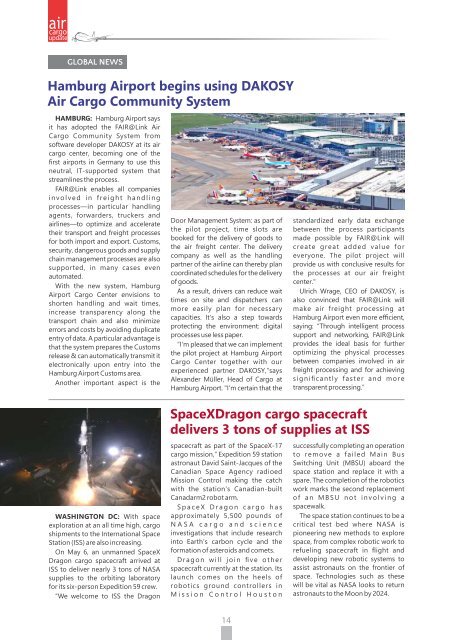Create successful ePaper yourself
Turn your PDF publications into a flip-book with our unique Google optimized e-Paper software.
GLOBAL NEWS<br />
Hamburg Airport begins using DAKOSY<br />
Air Cargo Community System<br />
HAMBURG: Hamburg Airport says<br />
it has adopted the FAIR@Link Air<br />
Cargo Community System from<br />
software developer DAKOSY at its air<br />
cargo center, becoming one of the<br />
first airports in Germany to use this<br />
neutral, IT-supported system that<br />
streamlines the process.<br />
FAIR@Link enables all companies<br />
i n v o l v e d i n f r e i g h t h a n d l i n g<br />
processes—in particular handling<br />
agents, forwarders, truckers and<br />
airlines—to optimize and accelerate<br />
their transport and freight processes<br />
for both import and export. Customs,<br />
security, dangerous goods and supply<br />
chain management processes are also<br />
supported, in many cases even<br />
automated.<br />
With the new system, Hamburg<br />
Airport Cargo Center envisions to<br />
shorten handling and wait times,<br />
increase transparency along the<br />
transport chain and also minimize<br />
errors and costs by avoiding duplicate<br />
entry of data. A particular advantage is<br />
that the system prepares the Customs<br />
release & can automatically transmit it<br />
electronically upon entry into the<br />
Hamburg Airport Customs area.<br />
Another important aspect is the<br />
Door Management System: as part of<br />
the pilot project, time slots are<br />
booked for the delivery of goods to<br />
the air freight center. The delivery<br />
company as well as the handling<br />
partner of the airline can thereby plan<br />
coordinated schedules for the delivery<br />
of goods.<br />
As a result, drivers can reduce wait<br />
times on site and dispatchers can<br />
more easily plan for necessary<br />
capacities. It's also a step towards<br />
protecting the environment: digital<br />
processes use less paper.<br />
“I'm pleased that we can implement<br />
the pilot project at Hamburg Airport<br />
Cargo Center together with our<br />
experienced partner DAKOSY,”says<br />
Alexander Müller, Head of Cargo at<br />
Hamburg Airport. "I'm certain that the<br />
standardized early data exchange<br />
between the process participants<br />
made possible by FAIR@Link will<br />
create great added value for<br />
everyone. The pilot project will<br />
provide us with conclusive results for<br />
the processes at our air freight<br />
center."<br />
UIrich Wrage, CEO of DAKOSY, is<br />
also convinced that FAIR@Link will<br />
make air freight processing at<br />
Hamburg Airport even more efficient,<br />
saying: “Through intelligent process<br />
support and networking, FAIR@Link<br />
provides the ideal basis for further<br />
optimizing the physical processes<br />
between companies involved in air<br />
freight processing and for achieving<br />
significantly faster and more<br />
transparent processing.”<br />
WASHINGTON DC: With space<br />
exploration at an all time high, cargo<br />
shipments to the International Space<br />
Station (ISS) are also increasing.<br />
On <strong>May</strong> 6, an unmanned SpaceX<br />
Dragon cargo spacecraft arrived at<br />
ISS to deliver nearly 3 tons of NASA<br />
supplies to the orbiting laboratory<br />
for its six-person Expedition 59 crew.<br />
“We welcome to ISS the Dragon<br />
SpaceXDragon cargo spacecraft<br />
delivers 3 tons of supplies at ISS<br />
spacecraft as part of the SpaceX-17<br />
cargo mission,” Expedition 59 station<br />
astronaut David Saint-Jacques of the<br />
Canadian Space Agency radioed<br />
Mission Control making the catch<br />
with the station's Canadian-built<br />
Canadarm2 robot arm.<br />
S p a c e X D r a g o n c a r g o h a s<br />
approximately 5,500 pounds of<br />
N A S A c a r g o a n d s c i e n c e<br />
investigations that include research<br />
into Earth’s carbon cycle and the<br />
formation of asteroids and comets.<br />
D r a g o n w i l l j o i n fi v e o t h e r<br />
spacecraft currently at the station. Its<br />
launch comes on the heels of<br />
robotics ground controllers in<br />
M i s s i o n C o n t r o l H o u s t o n<br />
successfully completing an operation<br />
to remove a failed Main Bus<br />
Switching Unit (MBSU) aboard the<br />
space station and replace it with a<br />
spare. The completion of the robotics<br />
work marks the second replacement<br />
o f a n M B S U n o t i n v o l v i n g a<br />
spacewalk.<br />
The space station continues to be a<br />
critical test bed where NASA is<br />
pioneering new methods to explore<br />
space, from complex robotic work to<br />
refueling spacecraft in flight and<br />
developing new robotic systems to<br />
assist astronauts on the frontier of<br />
space. Technologies such as these<br />
will be vital as NASA looks to return<br />
astronauts to the Moon by 2024.

















